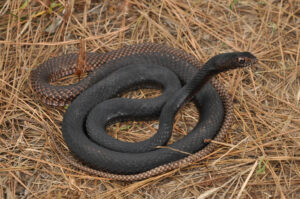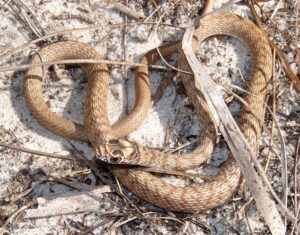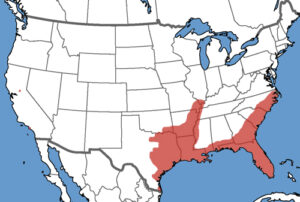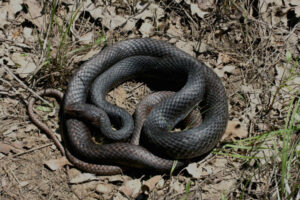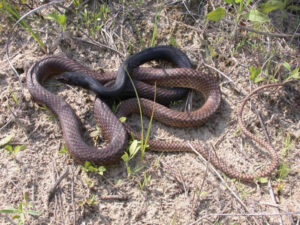Eastern Coachwhip (Masticophis flagellum flagellum)
Updated on
25/04/2024The eastern coachwhip is a subspecies of the coachwhip of whip snake. It is a long and slender colubrid indigenous to the southern United States. The active, fast-moving snake can reach speeds up to 5-8 km/h thanks to its streamlined body. It is active from March to November in the warmer parts of its range.
Scientific Classifications
- Family:Colubridae
- Genus:Masticophis
- Species: M. flagellumSpecies: M. flagellum
Conservation Status
Description
Size
The total size of an adult, including the tail, is 50-72 in (130-180 cm). The maximum recorded length is 102 in (260 cm). This makes them one of the largest native snakes in North America.
Color and Appearance
The head and neck are generally black, fading to tan towards the rear of the body. Some individuals may lack the dark neck and head color. Rarely are individuals completely black. The belly is usually pinkish and unmarked. Their common name is derived from their smooth scales and body color that make them look like a braided whip.
The juveniles are tan or brown with indistinct dark crossbands down the back.
Are They Dangerous to Humans
When disturbed, the colubrid usually flees fast. Sometimes, it vibrates the tip of its tail among ground litter making a sound reminiscent of rattlesnakes. When trapped, the eastern coachwhip aggressively defends itself by striking repeatedly and biting. The non-venomous bite leaves a series of shallow gashes on the attacker’s flesh. But it doesn’t chase a person and “whip him to death”, as the common legend goes.
Eastern Coachwhips at a Glance
Distribution
It ranges from eastern Kansas to eastern Texas in the west and from North Carolina to Florida in the east. Their absence from the Mississippi Delta divides their distribution into two separate groups.
Habitat
It can be found in a wide range of habitats but is most common in the southeastern coastal plain. The eastern coachwhip prefers pine-palmetto flatwoods, sandy pine woodlands, cedar glades, and regions along marshes, creeks, and swamplands. They can be found in suburban neighborhoods with developments encroaching on favored habitats.
Lifespan
The northwestern garter snake is thought to live for around 7 years in the wild. The maximum recorded lifespan is 15.8 years in captivity.
Predators
They fall prey to American crows, northwestern crows, and hawks.
Diet
Large insects, birds, lizards, other snakes, and small mammals form the diet of the eastern coachwhip.
The diurnal snake forages with its senses of smell and sight. It often hunts with its head raised above the ground and vegetation and visually focuses on its prey’s position before catching it, unlike most snakes. The action is similar to a periscope.
It doesn’t constrict its food but manipulates it to swallow it alive, head first. The serpent has sometimes been seen to beat its prey against the ground, apparently to stun it before ingesting. Its strong jaws have rows of tiny teeth that slant inwards.
Reproduction
Oviparous (lays eggs that hatch outside the body)
The female produces a clutch of 4-24 eggs in the breeding season that spans from June through August. The average clutch size is 11. The males reach sexual maturity when they are 1-year-old. But the females don’t do so till age 3.
The male instigates copulation with a female through courtship. The union can last for up to 130 minutes. As the mating system is polyandrous, the males exhibit territorial behavior to prevent further copulation by other males. After passing through a gestation period of 77.5 days, the female lays eggs in the burrows of small animals and doesn’t take parental care.
Source
inaturalist.ca, jaxshells.org, californiaherps.com, digital.sfasu.edu, srelherp.uga.edu

